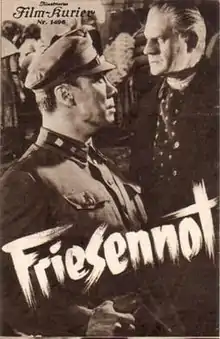Frisians in Peril
Frisians in Peril (German: Friesennot) is a 1935 German drama film directed by Peter Hagen and starring Friedrich Kayßler, Jessie Vihrog and Valéry Inkijinoff.[1] Made for Nazi propaganda purposes, it concerns a village of ethnic Frisians in Russia.
| Frisians in Peril | |
|---|---|
 | |
| Directed by | Peter Hagen |
| Written by | Werner Kortwich |
| Produced by | Alfred Bittins Hermann Schmidt |
| Starring | Friedrich Kayßler Jessie Vihrog Valéry Inkijinoff |
| Cinematography | Sepp Allgeier |
| Edited by | Wolfgang Becker |
| Music by | Walter Gronostay |
Production company | Delta-Film |
Release date | 19 November 1935 |
Running time | 97 minutes |
| Country | Nazi Germany |
| Language | German |
It was shot at the Grunewald Studios in Berlin. The film's sets were designed by the art directors Robert A. Dietrich and Bernhard Schwidewski. Location shooting took place around the Lüneburg Heath near Bispingen. It premiered at the Ufa-Palast am Zoo in the German capital.
Plot
Soviet authorities are making life as difficult as possible for a village of Volga Germans, most of whose ancestors originated in the Frisian Islands, with taxes and other oppression.[2]
After Mette, a half-Russian, half-Frisian woman, becomes the girlfriend of Kommissar Tschernoff, the Frisians murder her and throw her body in a swamp.[3]
Open violence breaks out and all of the Red Army soldiers stationed nearby are killed by the villagers. They then set fire to their village and flee.[3]
Cast
- Friedrich Kayßler as Jürgen Wagner
- Helene Fehdmer as Kathrin Wagner
- Valéry Inkijinoff as Kommissar Tschernoff
- Jessie Vihrog as Das Mädchen Mette
- Hermann Schomberg as Klaus Niegebüll
- Ilse Fürstenberg as Dörte Niegebüll
- Kai Möller as Hauke Peters
- Fritz Hoopts as Ontje Ibs
- Martha Ziegler as Wiebke Detlevsen
- Gertrud Boll as Telse Detlevsen
- Maria Koppenhöfer as Frau Winkler
- Marianne Simson as Hilde Winkler
- Franz Stein as Christian Kröger
- Aribert Grimmer as Kommissar Krappien
Motifs
Despite Nazi hostility to religion, a cynical piece of anti-Communist propaganda depicts the Communists as posting obscene anti-religious posters, and the Frisians as piously declaring that all authority comes from God.[4]
The portrayal of Kommissar Tschernoff does not conform to the heavy-handed depiction of Communists as brutal and murderous in such films as Flüchtlinge; he is truly and passionately in love with Mette, and only with her death does he unleash his soldiers.[3] A villager objects to the affair on the grounds that even though her mother was Russian, her father's Frisian blood "outweighs" foreign blood, and therefore she must not throw herself at a foreigner.[3] Her murder is presented as in accordance with the Nazi principle of "race defilement."[5]
Ban and reversal
After the Molotov–Ribbentrop Pact, in 1939, the film was banned; in 1941, after the invasion of Russia, it was reissued under its new title.[6]
References
- DE-DE-Marktforschungsstudien~Adcopy" target="_blank" style="font-size:12px;color:rgb(0. "New York Times: Friesennot (1936)". Movies & TV Dept. The New York Times. Archived from the original on 2012-07-10. Retrieved 2010-10-31.
{{cite news}}: CS1 maint: multiple names: authors list (link) - Erwin Leiser, Nazi Cinema, pp. 39-40 ISBN 0-02-570230-0
- Erwin Leiser, Nazi Cinema, p. 40 ISBN 0-02-570230-0
- Erwin Leiser, Nazi Cinema p40-1 ISBN 0-02-570230-0
- Richard Grunberger, The 12-Year Reich, p. 384, ISBN 0-03-076435-1
- Erwin Leiser, Nazi Cinema p. 41 ISBN 0-02-570230-0
External links
- Friesennot at IMDb
- Friesennot is available for free viewing and download at the Internet Archive